The Neuro-monitoring System Market is estimated to be valued at USD 3.8 billion in 2025 and is projected to reach USD 7.3 billion by 2035, registering a compound annual growth rate (CAGR) of 6.8% over the forecast period.
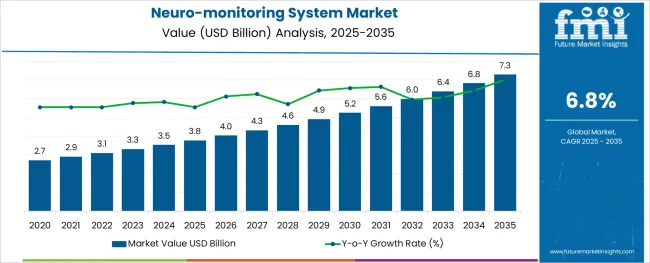
The neuro-monitoring system market is growing steadily as the need for real-time neurological assessment during surgeries increases. Advances in surgical techniques and a rising focus on patient safety have encouraged the integration of monitoring systems to prevent neurological damage. The growing prevalence of spine surgeries has further boosted demand for accurate intraoperative monitoring to improve surgical outcomes and reduce complications.
Healthcare facilities are investing in advanced neuro-monitoring technologies to support complex procedures and enhance recovery rates. Increasing awareness among surgeons about the benefits of neuro-monitoring and expanding hospital infrastructure are also key growth factors.
The market outlook is promising with continued innovation in system capabilities and expanding applications beyond traditional surgical uses. Segment growth is expected to be driven by Somatosensory-evoked Potentials (SSEP) in type, spine surgery as the primary application, and hospitals as the dominant end users.
The market is segmented by Type, Application, and End Users and region. By Type, the market is divided into Somatosensory-evoked Potentials (SSEP), Sub-sensory Evoked Potentials, Motor-sensory Evoked Potentials, Brainstem Auditory Evoked Potentials (BAEP), Visual Evoked Potentials (VEP), and Mapping for Motor-cortex. In terms of Application, the market is classified into Spine Surgery, Vascular Surgery, Orthopedic Surgery, and ENT Surgery.
Based on End Users, the market is segmented into Hospitals, Diagnostic Labs, Ambulatory Surgical Centers, and Outpatient Clinics. Regionally, the market is classified into North America, Latin America, Western Europe, Eastern Europe, Balkan & Baltic Countries, Russia & Belarus, Central Asia, East Asia, South Asia & Pacific, and the Middle East & Africa.
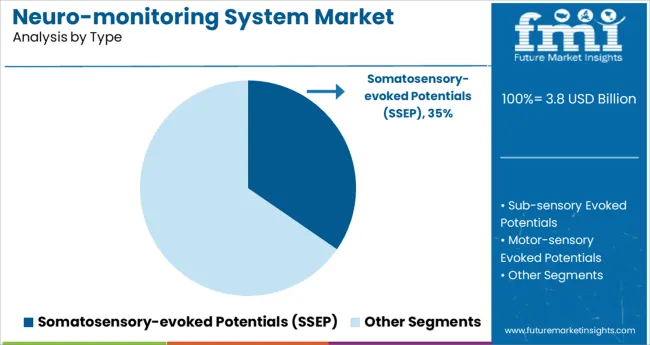
The Somatosensory-evoked Potentials segment is projected to hold 34.6% of the neuro-monitoring system market revenue in 2025. This segment’s growth is linked to its ability to monitor the functional integrity of sensory pathways during surgeries. It is widely used for its reliability in detecting potential neural injury in real time.
The adoption of SSEP is supported by its critical role in spine and brain surgeries where continuous monitoring is essential for patient safety. Its non-invasive nature and capacity to provide immediate feedback to surgeons have driven its preference.
As surgical procedures become more complex, demand for effective neuro-monitoring techniques like SSEP is expected to increase.

The Spine Surgery segment is expected to account for 39.2% of the market revenue in 2025. Neuro-monitoring systems have become standard practice during spine surgeries to avoid damage to the spinal cord and nerve roots. The increasing number of spinal procedures, including minimally invasive and corrective surgeries, has fueled demand for intraoperative monitoring solutions.
The segment’s growth is supported by heightened focus on improving surgical precision and patient outcomes. Regulatory standards and clinical guidelines have reinforced the importance of neuro-monitoring in spinal interventions.
As the volume of spine surgeries rises globally, this application segment will likely maintain its leading market share.
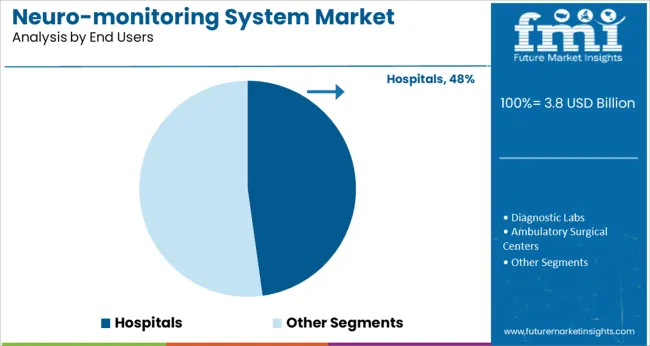
Hospitals are projected to represent 47.8% of the neuro-monitoring system market revenue in 2025, maintaining their position as the primary end users. The complexity of neuro-monitoring systems and the need for skilled personnel have made hospitals the preferred setting for their deployment.
Hospitals have increasingly incorporated these systems in operating rooms equipped for neurological and orthopedic surgeries. The growing investment in healthcare infrastructure and specialized surgical units has further supported market demand.
Hospitals also benefit from the integration of neuro-monitoring with other diagnostic and surgical technologies to enhance patient care. As healthcare delivery advances and surgical volumes increase, hospitals will continue to drive demand in this market.
Demand for neuromonitoring systems is likely to grow at a fast pace on the back of the rising prevalence of chronic diseases. The increasing number of road accidents is another major factor that is estimated to augur well for the market. Also, increasing awareness among doctors regarding the benefits of neuro-monitoring systems is expected to propel the market.
As these systems are capable of assessing the correct placement screws during surgeries, these can prevent the risk of nerve intrusion. At the same time, these can monitor the parts of the spinal cord that can further assist in the detection of sensory changes in an individual’s body.
The lack of knowledge about the availability of numerous cutting-edge healthcare devices, especially in underdeveloped countries is projected to hamper the expansion of the neuro-monitoring system market size.
Also, these systems require high initial installation costs, which may not be feasible for small-scale enterprises based in emerging economies. This factor may also obstruct the market in the evaluation period.
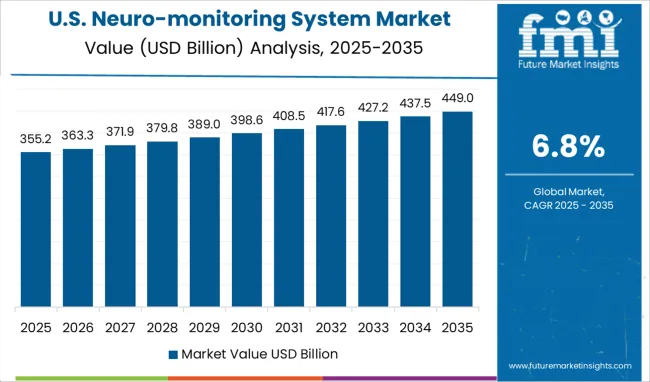
In terms of region, North America is likely to remain at the forefront by accounting for the largest neuro-monitoring system market share in the upcoming years.
This growth is attributable to the robust presence of various prominent healthcare device manufacturers in the USA and Canada. The availability of well-established healthcare infrastructure in these countries is another crucial factor that is estimated to augment growth.
In addition to that, the large patient population suffering from chronic diseases is set to contribute to this growth. The rising number of clinical trials conducted by research institutions to prove the therapeutic efficacy of neuro-monitoring systems is another significant factor that is expected to bolster the market.
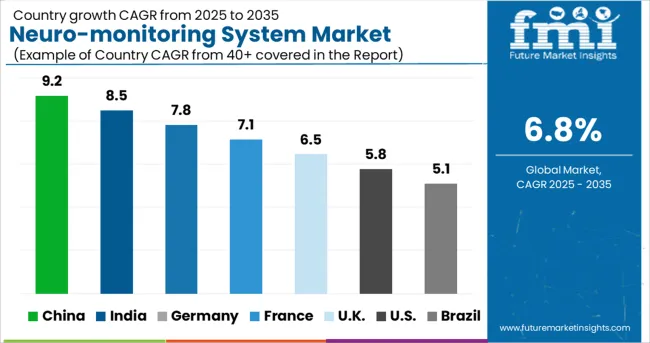
The easy availability of favourable medical reimbursement policies in China, Japan, India, and South Korea is projected to foster the Asia Pacific neuro monitoring system market growth in future years.
The increasing awareness among healthcare professionals about various clinical benefits related to nerve monitoring is anticipated to boost the regional market.
Furthermore, the growing usage of intraoperative nerve monitoring systems during various surgeries and ongoing technological advancements in the field of nerve stimulation is expected to aid growth. An increasing number of surgical centres and hospitals across the Asia Pacific owing to rising investments by governments is another vital factor that is set to drive the market.
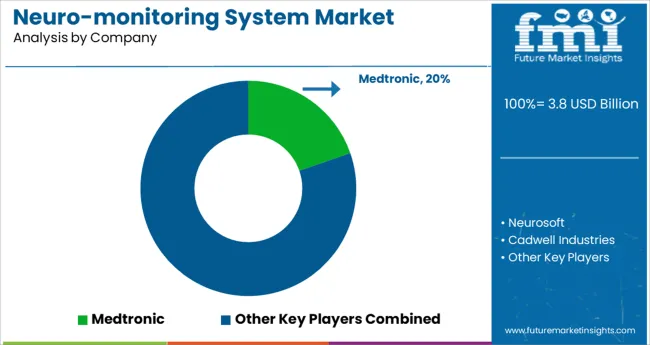
Some of the leading companies present in the global neuro monitoring system market include NuVasive Inc., Inomed Medizintechnik GmbH, AXIS Neuromonitoring, LLC, Accurate Monitoring, SpecialityCare, Medtronic, Biotronic NeuroNetwork Sentient Medical Systems, Natus Medical Incorporated, and Neuromonitoring Technologies among others.
The global market is highly competitive with the presence of a large number of key players. The majority of these companies are engaging in mergers and acquisitions with local enterprises to co-develop innovative products and attract more customers.
A few other companies in the market are striving to expand their portfolios by introducing novel products and surging sales of neuro-monitoring systems.
| Report Attribute | Details |
|---|---|
| Growth Rate | CAGR of 6.8% from 2025 to 2035 |
| Base Year for Estimation | 2024 |
| Historical Data | 2020 to 2024 |
| Forecast Period | 2025 to 2035 |
| Quantitative Units | Revenue in million and CAGR from 2025 to 2035 |
| Report Coverage | Revenue Forecast, Volume Forecast, Company Ranking, Competitive Landscape, Growth Factors, Trends and Pricing Analysis |
| Segments Covered | Type, Application, End Users, Region |
| Regions Covered | North America; Latin America; Western Europe; Eastern Europe; APEJ; Japan; Middle East and Africa |
| Key Countries Profiled | USA, Canada, Brazil, Argentina, Germany, UK, France, Spain, Italy, Nordics, BENELUX, Australia & New Zealand, China, India, ASEAN, GCC, South Africa |
| Key Companies Profiled | NuVasive Inc.; Inomed Medizintechnik GmbH; AXIS Neuromonitoring, LLC; Accurate Monitoring; SpecialityCare; Medtronic; Biotronic NeuroNetwork Sentient Medical Systems; Natus Medical Incorporated; Neuromonitoring Technologies |
The global neuro-monitoring system market is estimated to be valued at USD 3.8 billion in 2025.
It is projected to reach USD 7.3 billion by 2035.
The market is expected to grow at a 6.8% CAGR between 2025 and 2035.
The key product types are somatosensory-evoked potentials (ssep), sub-sensory evoked potentials, motor-sensory evoked potentials, brainstem auditory evoked potentials (baep), visual evoked potentials (vep) and mapping for motor-cortex.
spine surgery segment is expected to dominate with a 39.2% industry share in 2025.






Full Research Suite comprises of:
Market outlook & trends analysis
Interviews & case studies
Strategic recommendations
Vendor profiles & capabilities analysis
5-year forecasts
8 regions and 60+ country-level data splits
Market segment data splits
12 months of continuous data updates
DELIVERED AS:
PDF EXCEL ONLINE
System-On-Package Market Size and Share Forecast Outlook 2025 to 2035
Systems Administration Management Tools Market Size and Share Forecast Outlook 2025 to 2035
Systemic Sclerosis Treatment Market - Trends & Forecast 2025 to 2035
System on Module Market Growth – Trends & Forecast 2025 to 2035
SLE Drugs Market Insights - Growth & Forecast 2025 to 2035
Systemic Mastocytosis Treatment Market
Systemic Infection Treatment Market
5G System Integration Market Insights - Demand & Growth Forecast 2025 to 2035
VRF Systems Market Growth - Trends & Forecast 2025 to 2035
Rail System Dryer Market Size and Share Forecast Outlook 2025 to 2035
HVAC System Analyzer Market Size and Share Forecast Outlook 2025 to 2035
DWDM System Market Analysis by Services, Product, Vertical, and Region – Growth, Trends, and Forecast from 2025 to 2035
Brake System Market Size and Share Forecast Outlook 2025 to 2035
Cloud Systems Management Software Market Size and Share Forecast Outlook 2025 to 2035
Hi-Fi Systems Market Size and Share Forecast Outlook 2025 to 2035
X-ray System Market Analysis - Size, Share, and Forecast 2025 to 2035
Power System Simulator Market Growth - Trends & Forecast 2025 to 2035
Cough systems Market
Atomic System Clocks Market Forecast and Outlook 2025 to 2035
Closed System Transfer Devices Market Insights – Industry Trends & Forecast 2024-2034

Thank you!
You will receive an email from our Business Development Manager. Please be sure to check your SPAM/JUNK folder too.
Chat With
MaRIA